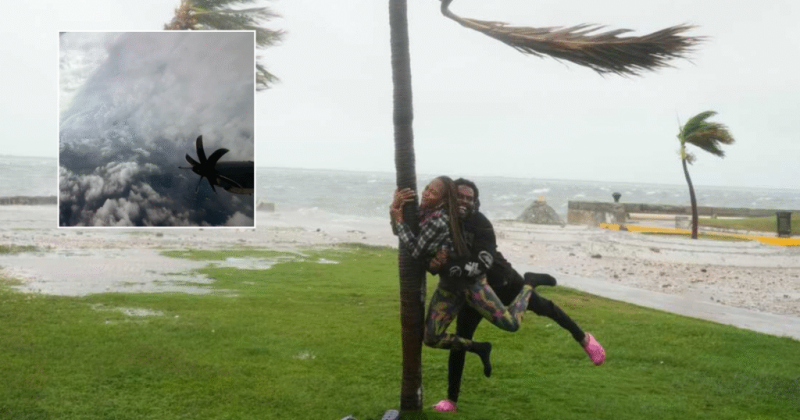Category 5 Hurricane Melissa — one of the most powerful storms ever recorded in the Atlantic — slammed into southwestern Jamaica on Tuesday, unleashing catastrophic flooding, devastating winds, and widespread destruction. Seven deaths and even more injuries have been linked to storm preparations.
With sustained winds reaching 185 mph (295 kph), the Category 5 hurricane Melissa ripped off roofs, uprooted trees, and sent boulders crashing onto major roads, leaving much of the island’s infrastructure in ruins.
Authorities confirmed that Melissa made landfall near New Hope, Jamaica, where entire neighborhoods were submerged under several feet of floodwater. “There is no infrastructure in the region that can withstand a Category 5,” Prime Minister Andrew Holness said grimly. “The question now is not whether there’s damage — it’s how quickly we can recover. That’s the challenge.”
WATCH: Footage shows the catastrophic aftermath of Category 5 Hurricane Melissa in Black River, Jamaica. pic.twitter.com/AKMBXUEMAt
— Resist Times (@ResistTimes_US) October 29, 2025
The southwestern parish of St. Elizabeth was hit especially hard. Desmond McKenzie, deputy chairman of Jamaica’s Disaster Risk Management Council, described the area as “completely underwater.” He said at least three families in the community of Black River were trapped in their homes by rising waters, and rescue crews were unable to reach them due to the dangerous conditions. “Roofs were flying off,” McKenzie said. “We are hoping and praying that the situation will ease enough for emergency teams to reach those people.”
Power outages were widespread, with 540,000 customers — nearly 80% of the island — left in the dark. Nearly 15,000 residents sought safety in government shelters as officials warned that conditions could worsen overnight.
Meteorologist Rohan Brown of Jamaica’s Meteorological Service cautioned that Melissa’s counterclockwise winds would drive a storm surge onto the island’s northern coast as the hurricane moved toward Cuba.
The ferocity of the storm terrified even seasoned islanders. “When the wind howls, it feels like the world is falling apart,” said 15-year-old Gavin Fuller of St. Elizabeth. “I just wanted to know what it feels like to stand in the eye of something so powerful.”
Emergency response teams struggled to operate amid relentless winds and debris. Colin Bogle, a Mercy Corps adviser sheltering with his grandmother in Portmore, said the noise was “deafening” and the atmosphere tense. “People are anxious and just trying to hold on until the storm passes,” he said after hearing a loud explosion that cut power to his neighborhood.
By Tuesday evening, Hurricane Melissa’s center had moved into the Caribbean Sea, about 50 miles east-northeast of Montego Bay and 160 miles southwest of Guantánamo, Cuba.
Footage from inside the eye of Category 5 Hurricane Melissa pic.twitter.com/tXeEjifwwn
— Breaking911 (@Breaking911) October 28, 2025
The U.S. National Hurricane Center reported that its central pressure — measured at 892 millibars — tied records with the 1935 Labor Day hurricane in Florida. Meteorologists Phil Klotzbach and Brian McNoldy called it “a beast of a storm,” noting that only Hurricane Dorian in 2019 matched its 185 mph winds.
Officials warned of storm surges up to 13 feet (4 meters), posing a severe threat to coastal hospitals and critical infrastructure. Four major hospitals sustained damage, with one losing power completely and requiring the evacuation of 75 patients.
In a desperate moment broadcast live on a local radio station, a caller pleaded for help for a woman in labor trapped in western Jamaica. The host urged listeners to locate the nearest safe hospital before an obstetrician phoned in to explain how to deliver a baby in an emergency.
As floodwaters continued to rise, officials warned residents to be alert for displaced crocodiles in Kingston’s low-lying areas. “We have boats, helicopters — you name it,” McKenzie said, assuring the public that the government was ready to begin rescues once conditions allowed.
Melissa has already been blamed for seven deaths across the Caribbean — three in Jamaica, three in Haiti, and one in the Dominican Republic — with another person still missing.
Jamaican officials are working with international agencies to coordinate relief efforts. Richard Thompson, acting director of the nation’s emergency management office, said teams would begin clearing debris and distributing aid as soon as the winds subside. Airports are expected to reopen by Thursday to allow the arrival of humanitarian supplies.
The United Nations and several nonprofit organizations had pre-positioned food, medical kits, and emergency resources before the storm struck. “This is going to be one of Jamaica’s toughest recoveries in modern history,” one UN relief coordinator said.
Melissa’s next target is eastern Cuba, where it is expected to make landfall early Wednesday as a major hurricane. Cuban President Miguel Díaz-Canel urged citizens to take the storm seriously, warning that it was “the strongest ever to hit national territory.”
In Santiago de Cuba, families crowded into the homes of relatives and neighbors seeking refuge. “We’re helping as best we can,” said 83-year-old Eduviges Figueroa, who was sheltering more than a dozen evacuees. “Now I’m cooking for everyone.”
Cuban authorities began mass evacuations in the eastern provinces of Holguín and Banes, moving over 200,000 people to shelters. Buses and trucks ferried evacuees through driving rain, with families clutching their children and belongings.
“May God have mercy on us,” said Diamon Mendoza, 36, who was preparing to ride out the storm with her family. “It’s coming with so much strength — anything can happen.”
As night fell, Hurricane Melissa continued its destructive path toward Cuba, leaving Jamaica reeling in its wake — an island battered but determined to recover from one of the most powerful hurricanes ever recorded in the Atlantic.

